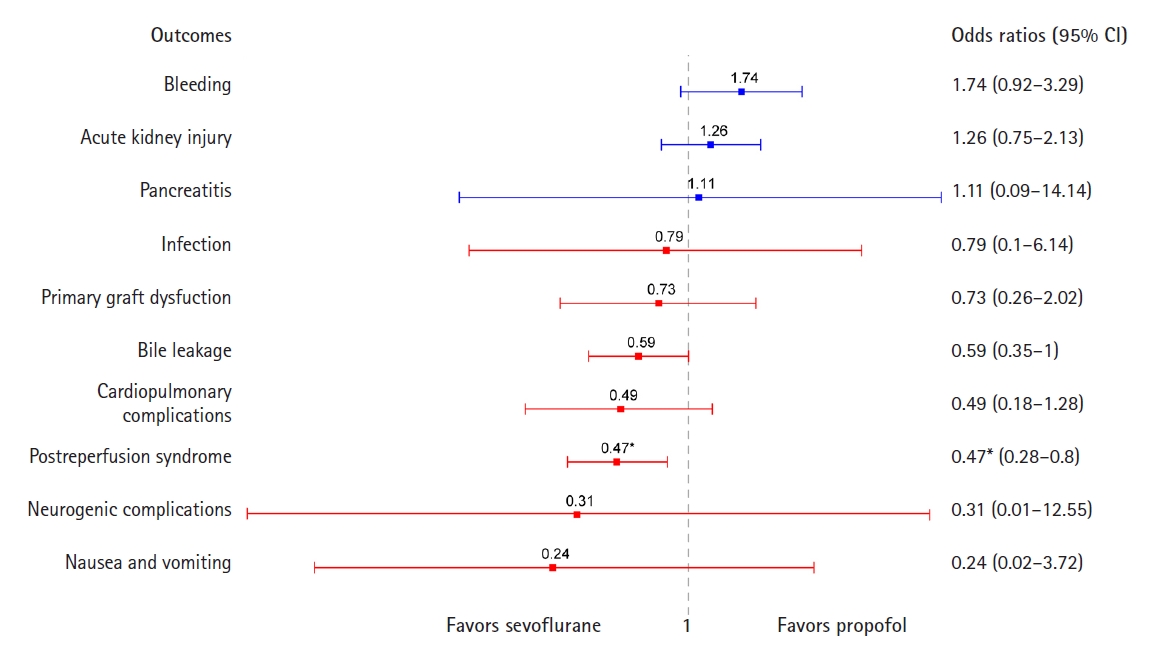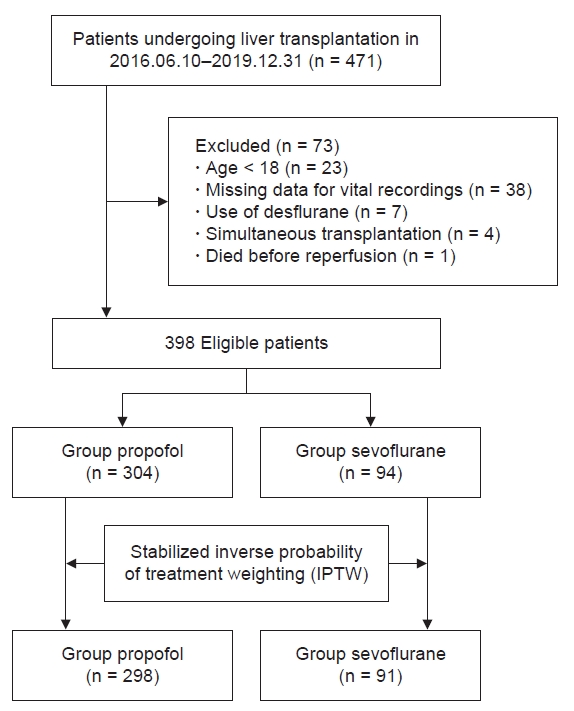 |
 |
- Search
| Anesth Pain Med > Volume 17(3); 2022 > Article |
|
Abstract
Background
Methods
Results
Notes
FUNDING
This research was supported by grant No. KSTA-2021-01 from the Korean Society of Transplantation Anesthesiologist.
DATA AVAILABILITY STATEMENT
The datasets generated during and/or analyzed during the current study are available from the corresponding author on reasonable request.
AUTHOR CONTRIBUTIONS
Conceptualization: Hye-Yeon Cho, Seong-Mi Yang. Data curation: Hye-Yeon Cho, Hyung-Chul Lee, Suk Kyun Hong. Formal analysis: Hye-Yeon Cho, Ho-Jin Lee, Seong-Mi Yang. Funding acquisition: Seong-Mi Yang. Methodology: Ho-Jin Lee, Seong-Mi Yang. Writing - original draft: Hye-Yeon Cho, Seong-Mi Yang. Writing - review & editing: Hye-Yeon Cho, Ho-Jin Lee, Won Ho Kim, Hyung-Chul Lee, Chul-Woo Jung, Seong-Mi Yang. Supervision: Chul-Woo Jung, Seong-Mi Yang.
Fig.┬Ā2.

Table┬Ā1.
Data are presented as number (%) or median (1Q, 3Q). IPTW: inverse probability of treatment weighting, SMD: standardized mean difference, MELD: model for end-stage liver disease, GRWR: graft weight to recipient body weight ratio, IVC: inferior vena cava, pRBC: packed red blood cells, FFP: fresh frozen plasma.
Table┬Ā2.
| Outcomes |
Before stabilized IPTW |
After stabilized IPTW |
||||||
|---|---|---|---|---|---|---|---|---|
| Propofol (n = 304) | Sevoflurane (n = 94) | P value | Odds ratio* (95% CI) | Propofol (n = 303) | Sevoflurane (n = 92) | P value | Odds ratio* (95% CI) | |
| PRS | 133 (43.8) | 29 (30.9) | 0.035 | 0.57 (0.35-0.93) | 127.6 (42.8) | 24.7 (27.2) | 0.018 | 0.47 (0.28-0.80) |
| Duration of hypotension after reperfusion (s) | 50.0 (0.0, 102.0) | 7.0 (0.0, 81.5) | 0.013 | - | 48.0 (0.0, 102.0) | 1.8 (0.0, 76.6) | 0.007 | - |
| PGD | 23 (7.6) | 9 (9.6) | 0.068 | 1.29 (0.55-2.81) | 22.5 (7.5) | 5.3 (5.9) | 0.565 | 0.73 (0.26-2.02) |
| AKI | 91 (29.9) | 30 (31.9) | 0.813 | 1.10 (0.66-1.79) | 85.7 (28.7) | 29.8 (32.7) | 0.533 | 1.26 (0.75-2.13) |
| ICU stay (d) | 7.2 (14.4) | 6.1 (4.8┬Ā) | 0.469 | - | 8.0 (16.1) | 6.0 (5.4) | 0.138 | - |
| Hospital stay (d) | 22 (16, 35) | 25 (19, 41.5) | 0.008 | - | 23 (16.0, 37.0) | 22 (17.0, 31.0) | 0.924 | - |
| Postoperative day discharge (d) | 17. (13, 26) | 18 (14, 26.8) | 0.088 | 17 (13.0, 27.0) | 17.7 (14.0, 24.0) | 0.656 | ||
| Major complications | ||||||||
| ŌĆā Infection | 7 (2.3) | 2 (2.1) | 1 | 0.93 (1.14-3.89) | 6.2 (2.1) | 1.2 (1.3) | 0.576 | 0.79 (0.10-6.14) |
| ŌĆā Bile leakage | 125 (41.1) | 20 (21.3) | 0.001 | 0.41 (0.23-0.69) | 121.6 (40.8) | 27.2 (29.9) | 0.123 | 0.59 (0.35-1.00) |
| ŌĆā Bleeding | 47 (15.5) | 20 (21.3) | 0.246 | 1.42 (0.77-2.54) | 48.2 (16.2) | 19.0 (20.9) | 0.369 | 1.74 (0.92-3.29) |
| ŌĆā N/V, DGE | 5 (1.6) | 2 (2.1) | 1 | 1.63 (0.22-8.49) | 6.0 (2.0) | 0.6 (0.7) | 0.167 | 0.24 (0.02-3.72) |
| ŌĆā Cardiopulmonary | 31 (10.2) | 6 (6.4) | 0.363 | 0.67 (0.24-1.57) | 34.0 (11.4) | 5.4 (6.0) | 0.206 | 0.49 (0.18-1.28) |
| ŌĆā Neurogenic | 3 (1.0) | 1 (1.1) | 1 | 1.07 (0.05-8.53) | 2.9 (1.0) | 0.3 (0.3) | 0.354 | 0.31 (0.01-12.55) |
| ŌĆā Pancreatitis | 2 (0.7) | 1 (1.1) | 1 | 1.62 (0.75-17.13) | 2.8 (0.9) | 0.9 (0.9) | 0.986 | 1.11 (0.09-14.14) |
REFERENCES
-
METRICS

-
- 1 Crossref
- 2,941 View
- 71 Download
- Related articles in Anesth Pain Med
- ARTICLE & TOPICS
-
- Topics
-
- Neuroscience in anesthesiology and critical care
- Anesthetic Pharmacology
- Obstetric Anesthesia
- Pediatric Anesthesia
- Cardiothoracic and Vascular Anesthesia
- Transplantation Anesthesia
- Spinal Pain
- Regional Anesthesia
- Neuromuscular Physiology and Pharmacology
- Airway Management
- Geriatric anesthesia and Pain
- Others








